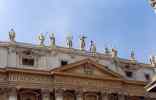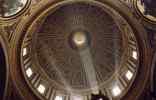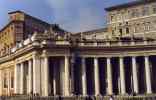BASILICA OF ST. PETER
The Basilica of St. Peter in the Vatican City of Rome is part of the UNESCO world cultural heritage. It is considered to be the largest church architecture in the world (length 211.5 m, height 132.5 m, dome diameter 42 m) which attracts thousands of visitors from all over the world every day wanting to visit the burial site of the apostle St. Peter and the principal church of the Pope. The Basilica of St. Peter as it stands today is the creation of many generations of architects. It reflects the spiritual conviction and the aesthetic ideals of the renaissance and baroque eras. From an architectural point of view, the Basilica of St. Peter is a typical renaissance building that was completed in a baroque style.
St. Peter’s Square
It’s an awesome feeling when one enters the gigantic ellipse comprising St. Peter’s Square which opens up to a bright and wide area right in front of the visitor’s eyes (273 resp. 226 m in diameter). In the center of the Square, a huge obelisk framed by two mighty spouting fountains towers out of the ground; Emperor Caligula had once brought this obelisk from Alexandria in Egypt to Rome by ship and had it erected in his circus, the coliseum. According to bible records, the obelisk witnessed the execution of the apostle St. Peter and his followers. More than 140 larger-than-life size holy sculptures stand on the 15 m tall colonnade of Bernini. The colonnade is wide enough so that two cars could easily pass through it.
Your attention is now drawn to the Basilica and the facade Carlo Madernos which bluntly separates the Square from the Basilica actually giving you more of a palatial impression. The massive structure of the facade with its columns and pillars reaching over two floors is very striking, as are the entrances, the balconies and the windows. It is the middle balcony on the second floor from where the Pope pronounces the papal blessing on important Christian holidays “Urbi et Orbi”, for the city and the world. It is also the place from where the name of the newly elected Pope as well as a canonization or beatification are publically announced. On top of the facade stand two 5.70 m high statues portraying Christ and the apostles.
Architectural history
According to biblical records the apostle St. Peter was laid to rest following his execution near Nero’s Circus. Above this tomb, Emperor Constantine ordered the first Vatican Basilica to be built in the fourth century in which Carl the Great was later crowned as Emperor. During the middle ages, the building became increasingly dilapidated until Pope Julius II appointed the architect Bramante in 1506 with rebuilding the Basilica. Starting in the year 1547, Michelangelo took over the construction work. He simplified Bramante’s ground plans in a most ingenious way by condensing it to a simple central structure. Bramante and Michelangelo had both planned a central structure with ground plans in the shape of a Greek cross. Following Michelangelo’s death, the architects Maderna and Bernini continued with the construction work. They modified the ground plans to the shape of a Latin cross; in other words, they added a nave, which adjoined with the diagonal facade facing St. Peter’s Square.
The Interior of the Basilica
In view of the fact that after seeing St. Peter’s Square, the eye of the visitor has become accustomed to vast expanse and magnitude, the interior of the Basilica of St. Peter appears less gigantic than one would have maybe expected. However, the interior offers room for more than 60.000 people. Besides the main altar, there are 29 additional side altars and 23 papal tombs. At this point one of the biggest works of art should be mentioned: Michelangelo’s Pieta which he sculptured out of the marble block as a 24 year old artist. The Basilica thus holds two of Michelangelo’s masterpieces with an enormous chronological gap between them; the Pieta which he created as a young man and the dome which the master created at the age of eighty.












